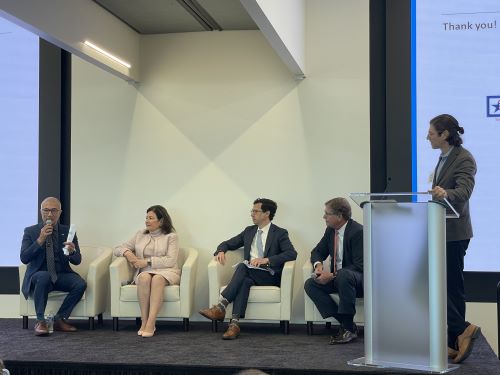Merit-Based Immigration and The Construction Industry Part I: Attempts to Define Merit
 In a booming American economy with 3.7% unemployment, President Donald Trump talks a lot about wanting to bring more people into our country to work on the basis of merit. Does merit apply to construction workers? This series of articles begins by examining recent legislative attempts define merit-based immigration, which have failed to take into account critical workforce shortages such as those in the construction industry.
In a booming American economy with 3.7% unemployment, President Donald Trump talks a lot about wanting to bring more people into our country to work on the basis of merit. Does merit apply to construction workers? This series of articles begins by examining recent legislative attempts define merit-based immigration, which have failed to take into account critical workforce shortages such as those in the construction industry.
“I want people to come into our country on a merit-based system, I want them to help all the great companies that are moving back into the United States. With what we’ve done, we’ve become so successful that we need people to come in with all these companies that are coming in but we want great people that love our country, that respect our country, and that want to work,” said President Trump at a recent MAGA rally in Kentucky.
Merit is defined as the quality of being particularly good or worthy, so how should the United States define who is the most worthy of obtaining permission to live and work here? Merit-based immigration systems like those in Canada and Australia give points to a prospective immigrant based on various qualities and achievements. Prospective immigrants must accrue enough points to pass a certain threshold in order to qualify for a visa. For what qualities should an American merit-based immigration system award points, and what should the threshold be?
Rather than awarding points for an applicant’s potential salary, a merit-based immigration system should award points for an applicant’s skills and attributes that allow them to produce and contribute value economically, especially in alignment with market demands and filling open jobs for which qualified Americans are unavailable.
US lawmakers attempted to develop a formula to determine immigrants’ merit in the RAISE Act, which has virtually no chance of passing at this point in time because it would significantly reduce overall immigration levels at a time when the US economy is already operating at better than full employment and starving for more workers. While the RAISE Act may have properly assigned merit points for certain qualities, it fell short in other areas.
One factor widely accepted and considered to increase an immigrant’s ability to contribute to a society is possessing proficiency in that society’s language. In other words, immigrants who can speak English well enough to pass the International English Language Testing System (IELTS) or the Test of English as a Foreign Language (TOEFL) are more likely to be able to achieve financial stability and contribute to America fiscally and economically than non-english speaking immigrants. Appropriately, the RAISE Act awards a greater number of points for the higher English proficiency a visa applicant demonstrates.
An additional attribute of prospective immigrants that may increase merit is having a family network in the US to aid with assimilation. While many conservatives advocate for a change in the US Immigration system from “chain” or family-based immigration to merit-based, family ties in the US should still be considered as a positive in terms of merit because when an immigrant with American family members comes to the US, if they need guidance or help, they will be able to depend on their family members and friends to help support them in their transition, as opposed to the government and taxpayers. For this reason, perhaps a merit-based immigration system should award some points for family ties in the US.
Another factor that is likely to determine an immigrant’s ability to succeed in contributing to American society fiscally and economically is having a prospective employer and job lined up. If an employer can provide evidence that there are no Americans who are willing or able to do that job, then that employer should be able to fill it with a skilled immigrant worker for the betterment of the American economy and its citizens.
While the proposed RAISE Act would award points to visa applicants for having a prospective employer, it would only do so for those whose salary would be above 150% of the median household income of the state that applicant would work in, with an increasing number of points in correlation with higher salaries. This aspect of the RAISE Act fails to properly define merit because many of the unfilled jobs in the American economy right now do not pay 150% above median household income. A proper merit-based immigration system should allow for the entry of workers to fill any job that Americans are unavailable or unwilling to take but that our economy and businesses need done, because even jobs that pay below 150% of the median household income provide worth and contribute value to our economy and society. The specific amount of money an individual receives in compensation for their work is not necessarily directly correlated with the amount of value they provide. This factor of the RAISE Act also seems counterintuitive if the purpose of a merit-based immigration system is to benefit American citizens because one would think the higher paying jobs should be reserved for Americans and filled by immigrants only as a last resort when there are not enough qualified Americans to take them.
An additional factor of the RAISE Act awards merit points to prospective immigrants for level of formal education they have attained, with 1 point for a US or Foreign High School degree, going all the way up to 13 points for a US professional degree or Doctoral STEM. While formal education typically increases the potential value an individual may provide to a society and economy, the RAISE act fails to award points for other forms of education such as craft skill specialization. If there is a shortage of skilled craft professionals (as there currently is), then prospective immigrants with a proclivity for or experience in craft skills certainly have a specific type of value and worth to provide our economy that even doctors or other highly formally educated individuals would be unable to provide. For this reason, in addition to simply awarding merit points for the level of formal education attained, points should be awarded for trade interest or certifications, especially in coordination and adjustment with labor market demands based on what type of skilled workers the economy needs currently and will require in the near future.
In assessing merit for the two previously mentioned factors, the authors of the RAISE Act assumed that immigration of lower wage and less formally educated immigrants would decrease wages of native born Americans. However, Alex Nowrasteh, a senior immigration policy analyst at the CATO Institute, has shown that immigrants actually have a net positive effect on Americans' wages, especially on Americans with more skills and higher levels of education.
An additional factor that was not directly addressed in the RAISE Act was the ability to pass a background check. While this may not necessarily define an individual's ability to contribute value to the American economy, it certainly has implications on an individual's potential effect on American society. Prospective immigrants with no criminal records, including unauthorized immigrants who are already living in this country, should be given priority. Applicants who have comitted violent or property crimes should be disqualified.
There are two other factors the RAISE Act awarded merit points for. One was for investing over $1.35 million in a new US commercial enterprise, and the other was for accomplishing exceptional achievements such as winning an Olympic gold medal or earning a Nobel prize. While these factors certainly have merit, they are special cases that do not apply to fixing the US workforce shortage.
The construction industry is currently being impacted by labor shortages. The Associated General Contractors of America recently conducted a survey that revealed 80% of contractors are having difficulty finding qualified craft workers. So shouldn’t merit-based immigration be applicable for such a critical industry? If so, how should it be defined?
We will explore these questions in Part II of this series...








